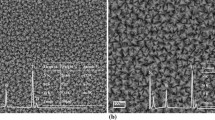Conclusions
-
1.
In indium films of the test thicknesses, an anomaly is observed in the temperature dependence for ultimate strength; values are close to those for solid metal whereas yield point and CSS are much higher.
-
2.
The presence of grain boundaries affects both indium film strength properties and stress relaxation parameters.
-
3.
Maximum strain and the amount of stress drop in films are more significant than in solid metal.
-
4.
Depending on deformation and temperature, internal stresses in test films may be 0.4–0.9 of the applied loads.
-
5.
The mechanism controlling indium film plastic strain may be crossover of moving dislocations with forest dislocations.
Similar content being viewed by others
Literature cited
L. S. Palatnik and A. I. Il'inskii, “Mechanical properties of metal films,” Usp. Fiz. Nauk,95, No. 4, 613–645 (1968).
L. Maiseel and R. Gleng (eds.), Thin Film Technology [in Russian], Vol. 2, Sov. Radio, Moscow (1977).
L. S. Palatnik, A. I. Il'inskii, G. V. Fedorov, and V. S. Dyachenko, “Connection between preparation conditions and strength of copper and aluminum vacuum condensates,” Izv. Vyssh. Uchebn. Zaved., Fiz., No. 1, 122–128 (1966).
L. S. Palatnik, M. E. Shcherbina, and V. M. Bratsykhin, “Growth of indium single crystal films by directional crystallization,” Izv. Akad. Nauk SSSR, Neorg. Mater.,16, No. 2, 345–346 (1980).
M. E. Shcherbina and V. N. Zaruba, “Microdeformation machine for testing thin films with automatic recording of the tensile diagram,” Tomsk (1980) (Deposited at VINITI, No. 674-80).
L. S. Fomenko, S. V. Lubenets, B. I. Startsev, and V. N. Nikiforenko, “Plastic deformation of indium single crystals in the temperature range 4.2–300 °K,” Fiz. Met. Metalloved.,42, No. 1, 160–169 (1976).
B. I. Dotsenko, “Low-temperature stress relaxation in normal and superconducting bcc metals,” Author's Abstract of Candidate's Dissertation, Phys.-Math. Sci., Kharkov (1976).
L. D. Sokolov, V. A. Skudnev, V. M. Solenov, et al., Mechanical Properties of Rare Metals [in Russian], Metallurgiya, Moscow (1972).
V. A. Fedorov, V. M. Finkel', and V. P. Plotnikov, “Crack growth at grain and twin boundaries,” in: Interaction of Crystal Lattice Defects and Metal Properties [in Russian], Tula (1979), pp. 143–148.
Author information
Authors and Affiliations
Additional information
Translated from Problemy Prochnosti, No. 4, pp. 86–89, April, 1981.
Rights and permissions
About this article
Cite this article
Palatnik, L.S., Shcherbina, M.E. & Litvinenko, A.A. Features of indium-film strength characteristics. Strength Mater 13, 496–499 (1981). https://doi.org/10.1007/BF00762506
Received:
Issue Date:
DOI: https://doi.org/10.1007/BF00762506




